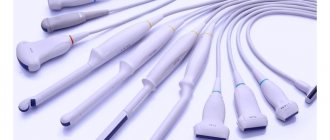If a woman is planning a child and is looking forward to pregnancy, every little detail becomes important. The days until ovulation are counted, ovulation is monitored using special tests or according to a basal temperature chart, then the tedious wait for the day of delay .
I would like to do the test as soon as possible so that it finally shows the desired result . But doctors unanimously repeat: “Expect delays!”, and the test manufacturers are in cahoots with them, promising information content and accuracy only after menstruation does not arrive on time. Is it so important to wait for the delay, or can the test still be done earlier ? Let's figure out what day after ovulation the test can show the correct result.
What does the strip react to?
The test strip is impregnated with special compounds. The reagent reacts to a substance that is produced in the female body after conception. Chorionic gonadotropin is necessary for the embryo to properly consolidate and further develop. Based on the indicators, you can judge how the fetus develops and the characteristics of pregnancy.
Normally, this substance is capable of rapid increase. The average doubling time is two days. During this time, there is a significant increase in gonadotropin. Many pregnancy tests react to an hCG of more than 25 units. This is the average sensitivity of the strips. But the modern pharmaceutical industry also offers more sensitive tests. They can react even at 10 units. If you correctly calculate the day of ovulation, you can easily determine when to take a pregnancy test.
What signs indicate that it is time to take a test?
The initial signs of pregnancy appear with varying intensity. Many people, soon after fertilization, begin to feel that changes are taking place in their body. And for some, only a significant delay in menstruation or a visit to the doctor suggests a possible pregnancy.
A reliable sign of pregnancy is the absence of menstrual bleeding; in addition, the following symptoms may indicate fertilization:
- Characteristic bloody discharge, signaling that implantation has occurred, that is, the embryo has penetrated into the thickness of the uterus.
- An increase in the size and sensitivity of the mammary glands, which indicates changes occurring in the breast tissue. After conception, the glands begin to rebuild, the female body prepares for lactation.
- Some women's taste preferences change. This occurs due to a deficiency of essential substances in the woman’s body. The expectant mother may experience cravings for foods that she previously did not like, and may also want things that are not edible (for example, chalk).
- A fairly common symptom is frequent urination. This is due to the restructuring of the hormonal system and relaxation of the bladder sphincters.
- The woman experiences weakness and fatigue, she is constantly sleepy, her memory and ability to concentrate decrease.
All the above symptoms are caused by hormonal changes that occur in the body of a pregnant woman.
How to calculate ovulation
A woman's reproductive function depends on her hormonal levels. A specific substance is responsible for each part of the cycle. In the first days of the cycle, estrogen is actively produced in the body. This hormone is necessary for the formation of the endometrium. It is the inner layer of the uterus into which the fertilized egg is embedded. The more voluminous the endometrium, the better the embryo is fixed. The average duration of this period is 10–14 days. Estrogen is also responsible for the growth and development of the follicle. A follicle is a growth on the ovary that contains an egg. Thanks to this hormone, the follicle quickly increases in size. A high-quality follicle is considered to be one that measures from 21 to 23 mm.
In order for the walls of the follicle to break through and the egg to leave it, lutein-stimulating hormone comes into play. It is responsible for opening the follicle walls. This is ovulation. In rare cases, lutein-stimulating hormone increases before the follicle has time to mature. Against this background, a woman may lose ovulation or the cell may be unable to conceive.
There are other indicators by which a woman can determine the day of ovulation. Symptoms include:
- Pain in the lower abdomen;
- Changes in the properties of cervical discharge;
- Increased appetite;
- Body temperature rarely rises.
All of these symptoms may indicate that ovulation is approaching. Doctors advise determining this period by basal temperature. It accurately indicates the day of ovulation. With a sharp increase in LSG, the temperature decreases by several units. In medicine, this concept is called retraction. This will be the exact day of ovulation.
Causes of early ovulation
Early release of the egg into the abdominal cavity can occur for a number of reasons:
- A short menstrual cycle itself suggests an early onset of ovulation.
- Stress, nervous tension.
- Change of place of residence, time zones, climate zones.
- Smoking, alcohol abuse.
- Hormonal imbalance: excess production of gonadotropins, estrogens, hyperthyroidism.
- Incorrect use of hormonal medications or adverse reactions to them.
- The period after termination of pregnancy.
- Lactation period.
- Cancellation of combined oral contraceptives.
How does conception occur?
When the egg leaves the follicle, it enters the fallopian tubes. When united with a male reproductive cell, a zygote is formed. The fertilized egg travels through the tubes through the fleecy layer and is implanted into the endometrium. The average duration of cell movement is 3–5 days.
The attached cell begins to actively divide. A zygote is formed. At this stage, human chorionic gonadotropin is detected in the woman’s blood and urine.
The first indicator is 2 muL. Gradually this figure is increasing. Every other day, 4 muL is detected. So, gradually this figure increases by week 12 to 4–5 thousand units. Based on these numbers, you can easily calculate when the test will show a positive result. When calculating, it turns out that you can find out for sure whether conception occurred 12–13 days after ovulation. This way you can determine on what day after ovulation the test will show the most reliable result.
Calculating the day for an ovulation test
Since LH (luteinizing hormone) is always present in the body and only sharply increases in volume before ovulation, tests need to be done for several days in a row to detect a “spike”. For ladies with a regular cycle, up to 5 days are enough to detect it.
But first of all, you need to figure out what day to do an ovulation test after your period. A special formula is provided for this. It involves the duration of the cycle. It is determined according to the following principle: the duration from the first day of menstruation to the beginning of the next. You need to subtract 17 from the cycle size. The resulting number is the day that needs to be counted from the beginning of the previous menstruation. On this day, start testing.
On what day to take the test in a 28 day cycle?
For your convenience, we recommend using our ovulation calculator, which will allow you to calculate your estimated date online.
So, calculation on what day to do an ovulation test if the cycle is 28 days: 28-17. The resulting number is 11. This means that from the first day of menstruation you need to count 10 days and, starting from the 11th, carry out testing. It is worth remembering that each body works with its own characteristics and in some cases five days may not be enough to detect a hormone release. According to reviews, sometimes 7-10 tests are required.
On what day to do the test with a cycle of 23-34 days
On what day to do an ovulation test with a 30-day cycle or another, you can find out from the table:
- On the 5th – with a cycle of 22 days;
- 6th – 23 days;
- 7th – 24 days;
- 8th – 25 days;
- 9th – 26 days;
- 10th – 27 days;
- 11th – 28 days;
- 12th – 29 days;
- 13th – 30 days;
- 14th – 31 days;
- 15th – 32 days;
- 16th – 33 days;
- 17th – 34 days;
- 18th – 35 days;
- 19th – 36 days;
- 20th – 37 days;
- 21st – 38 days;
- 22nd – 39 days;
- 23rd – 40 days.
On what day should I test if I have an irregular cycle?
These calculations are optimal for normal, undisturbed cycles. But what if menstruation is not systematized and it is not possible to identify a clear cycle, even with a small error?
On what day to do an ovulation test if you have an irregular cycle?
Experts recommend starting at the minimum date and testing until a sharp increase in luteinizing hormone is detected. That is, the correct answer on what day to do an ovulation test with an irregular cycle will be - starting with the smallest one that was observed in the woman. If it was not possible to identify it in advance, it is better to start from the fifth day. Of course, in this case, many more strips will be needed to identify the optimal moment for conception.
In the article - Ovulation calculator for irregular cycles, you will find useful information for yourself on this.
It is worth remembering that even in the most normal organism, failures can occur. For example, you can get pregnant if you conceive on “safe” days before and after your period - such cases are quite common. This once again confirms that ovulation does not necessarily occur in the middle of the cycle and is not always regular. The following reasons may affect the change in deadline:
- stress;
- illness, infection;
- climate change.
How to choose a test strip
Modern pharmacies offer a wide selection of pregnancy test strips. When buying, a woman finds it difficult to determine which one is right for her. For this reason, the following factors must be taken into account:
- Price range;
- Strip sensitivity;
- Good feedback.
Gynecologists believe that the quality of the test does not depend on its price. Although in fact you can pay attention to a number of features of such a product. A cheap pregnancy test has a narrow field of reagent. Some have dents and chips. In this case, a repeat purchase may be necessary. A more expensive product has a number of advantages. The test's reagent field is wider; many have a plastic body. The result is clearer. There are also electronic tests. They are able to calculate the exact duration of pregnancy after ovulation.
The sensitivity of the test must also be taken into account. Most of the products offered have a sensitivity of 25 units. This means that a woman can get the correct result 2–3 days after her cycle is delayed. This is also stated in the annotation. If such a strip is used before the delay occurs, the result may be erroneous. For this reason, it is recommended that you carefully examine the secondary packaging. On the box, the manufacturer indicates the sensitivity and precisely prescribes how many days after ovulation this test can be done.
If a woman wants to know the result before the delay, it is necessary to choose a more sensitive strip. When purchasing, you should also pay attention to the number of units at which this strip is triggered. If the test has a sensitivity of 15 U, then the correct result can be obtained only on days 9–10. In this case, the strip can be used before the start of the menstrual cycle.
In some pharmacies you can find a test with a more sensitive reagent. This strip reacts to hCG from 10 units. This product can be used 7-8 days after ovulation.
Many patients complain that the test is defective or does not show a positive result if they are pregnant. In order not to purchase such a product, you should study the reviews of other customers. To do this, you can use the Internet or consult a gynecologist.
When can you take a pregnancy test after ovulation?
The ovulatory days are behind us, and the time in anticipation of a happy day passes very slowly. Doubts and questions arise every day - when can you find out about conception and how many days later can you take a test if a whole week has passed since ovulation?
Maybe if you take a urine pregnancy test right now, it will show the 2 desired stripes? And this will paint life with rainbow colors of happiness. Impatient waiting forces a woman to do a lot of unnecessary and useless actions ahead of time. If a miracle happens after ovulation, you may not find out about it right away. How many days later pregnancy will manifest largely depends on the movement of the embryo through the woman’s genital tract.
At 1 week after conception, the fertilized egg goes through several stages of development, moving towards the uterus and becoming an embryo along the way. Before the next menstruation is delayed, the future fetus goes through the following stages:
- fragmentation, when a multicellular structure is formed from several cells;
- blastocyst formation;
- implantation;
- primary formation of the embryo.
14 days after ovulation, by the time the first day of menstruation was absent, the embryo had firmly attached to the wall of the uterus and the process of formation of the special hormone human chorionic gonadotropin (hCG) had begun. This is what a pregnancy test will react to when a woman, without waiting for her menstruation, tries to dispel her doubts.
Sometimes you can feel the moment of implantation, which in some women is manifested by scanty and spotting pink-bloody vaginal discharge.
However, you should not take a pregnancy test: it does not matter how many days after ovulation you take the test if there is no hCG in the blood and urine. Only the presence of this hormone will be an accurate confirmation of the miracle of the birth of a new life.
Taking an early test in most cases will be a disappointing event: there is no need to rush, because untimely and incorrect testing will only bring negative emotions. It is optimal to do a pregnancy test under the following conditions:
- mandatory presence of menstruation delayed by at least 1 day;
- testing should only be done in the morning;
- urine should be concentrated (collected after a night's sleep for at least 6 hours);
- Be sure to follow all instructions.
If conception occurs after ovulation, then a test with a delay in menstruation will definitely show pregnancy. Sometimes you can get a questionable result when the 2nd stripe is pale and hard to see. In this case, you can repeat the test the next morning.
It happens that the test is negative, but conception has occurred. This is quite possible if a woman is in a hurry. It is important to know how many days after ovulation to start taking a pregnancy test.
If the time period is violated (2 weeks), when testing is performed 10 days after ovulation, the test will show a negative result. A false negative test can be obtained in the following cases:
- early implementation;
- conducting the test in the afternoon or evening;
- failure to follow the sequence of actions;
- violation of instructions.
Sometimes the test will be false negative 21 days after ovulation. This is possible in situations where the hCG level increases slowly. In this case, it is better not to do a standard test, but to donate blood to determine the concentration of hCG.
When little time has passed after ovulation and conception (less than 4 weeks), there is no need to go to the doctor if the woman has previously completed all stages of preconception preparation and knows that from the moment of a positive test she must start taking folic acid supplements. In the first weeks of embryo development, a woman needs to minimize all risks, for which she must follow the following recommendations:
- rejection of bad habits;
- stopping or refusing to take any medications without a doctor’s prescription;
- stopping hard work and avoiding harmful working conditions;
- preventing stressful situations while maintaining psycho-emotional balance.
There is no need to go to a paid ultrasound diagnostic office to dispel any last doubts: exposure to ultrasonic waves in the very early stages of embryo development can have a negative effect on the baby.
The impatient anticipation of future happiness forces women to take a lot of unnecessary or harmful actions ahead of time. There is no need to take a pregnancy test a few days after ovulation because the result will be negative.
The best time to determine whether conception has occurred is from the moment of missed menstruation. In some cases, even in the absence of critical days, you can wait a little to be sure of the occurrence of a miraculous event.
Based on materials from karapuzdoma.ru
How to use the strip correctly
The pregnancy test contains precise instructions that spell out the rules for performing the test. To get an accurate result, you must do the analysis exactly according to the instructions.
All manufacturers advise doing the test in the morning. This is necessary for the accumulation of hCG in the urine. The more concentrated liquid is collected in the morning or 4 hours after the last visit to the toilet. It is also not recommended to drink large amounts of water and other liquids. They have a diluting effect on urine. In this case, the result will be unreliable.
The strip itself should also be used correctly. In all tests, the reagent is applied to a part that is dropped into the urine. In order for it to be distributed correctly and evenly over the strip, it should be held in a strictly vertical position. If the woman does not do this, then part of the reagent may reach the field only after some time. When dry it forms a stripe. A woman can regard this result as positive. To avoid mistakes, you must follow this rule.
Also, each strip contains a different amount of reagent and is made of different paper. Full distribution of the composition occurs after a certain time. For each strip, the instructions indicate how long you need to keep the test in the liquid. This condition should not be neglected. If the strip is underexposed or overexposed, the result may also be erroneous. After the reagent field has been wetted, the test should be placed on a flat horizontal surface. This is also necessary for proper distribution of the reagent. If you hold the strip in your hands or place it vertically in the package, the reagent can quickly drain from the field. The test will not have time to react. Pregnancy will not be determined.
All manufacturers also prescribe the time after which the test can show the correct result. In the case of an electronic gadget, this condition is not required. It calculates the time itself and gives accurate results. If a woman used a regular strip, it is necessary to carefully examine it strictly after 5 minutes. A later examination is not recommended. After drying, the reagent may appear on the field. A woman will regard this result as positive.
In what cases is the result erroneous?
A test can show an erroneous result for many reasons.
One of the reasons is incorrect determination of the timing of ovulation. Early use of the test in this case is ineffective. The test may also show an error if you drink a lot of liquid. Diluted urine contains minimal amounts of hCG. The result will be negative. Hormonal imbalance can also affect the indicators. The effectiveness of testing depends entirely on compliance with the rules for its use. If a woman follows the instructions and accurately determines the day of ovulation, she will receive a reliable result.











